Analysis of Water Quality Improvement Effect of Controlled River by Multi-Functional Weir Operation
Abstract
1. Introduction
2. Research Background
2.1. Pulsed Flow
2.2. EFDC (Environmental Fluid Dynamics Code) Overview
3. Study Methods
3.1. Descriptions of Study Area
3.2. Model Input Data
3.3. Calibration & Validation of EFDC Model
4. Results
4.1. Results of Scenario by Multi-Functional Weir Operation
4.2. Analysis of Water Quality Improvement effect
5. Discussion
6. Conclusions
Author Contributions
Funding
Institutional Review Board Statement
Informed Consent Statement
Data Availability Statement
Conflicts of Interest
References
- Watts, R.J.; Allan, C.; Bowmer, K.H.; Page, K.J.; Ryder, D.S.; Wilson, A.L. Pulsed Flows: A Review of Environmental Costs and Benefits and Best Practice; Waterlines Report; National Water Commission: Canberra, Australia, 2009; p. 16. [Google Scholar]
- Brandt, S.A. Classification of geomorphological effects downstream of dams. Catena. 2000, 40, 375–401. [Google Scholar] [CrossRef]
- Research on Implementing the Harmful Algal Bloom Alert System for Weir in the Nakdong River watershed, NIER RP2013-249. Available online: https://dl.nanet.go.kr/ (accessed on 1 January 2014).
- Thoms, M.C.; Walker, K.F. Channel changes associated with two adjacent weirs on a regulated lowland alluvial river. River Res. Appl. 1993, 8, 271–284. [Google Scholar] [CrossRef]
- Baker, P.D.; Brookes, J.D.; Burch, M.D.; Maier, H.R.; Ganf, G.G. Advection, growth and nutrient status of phytoplankton populations in the lower River Murray, South Australia. River Res. Appl. 2000, 16, 327–344. [Google Scholar] [CrossRef]
- Mitrovic, S.M.; Chessman, B.C.; Bowling, L.C.; Cooke, R.H. Modelling suppression of cyanobacterial blooms by flow management in a Lowland River. River Res. Appl. 2006, 22, 109–114. [Google Scholar] [CrossRef]
- Fovet, O.; Genthon, O.; Litrico, X.; Belaud, G. Managing invasive algae with flushing flows: New perspectives for canal control. In Proceedings of the World Environmental and Water Resources Congress 2012, Albuquerque, NM, USA, 20–24 May 2010; pp. 2177–2187. [Google Scholar] [CrossRef]
- Chung, S.W.; Kim, Y.K. Impact of a flushing discharge from an upstream dam on the NH3-N concentrations during winter seasons in Geum River. J. Korean Soc. Water Environ. 2005, 21, 609–616. [Google Scholar]
- Chong, S.A.; Yi, H.S.; Hwang, H.S.; Kim, H.J. Modeling the Flushing Effect of Multi-purpose Weir Operation on Algae Removal in Yeongsan River. J. Korean Soc. Environ. Eng. 2015, 37, 563–572. [Google Scholar] [CrossRef]
- Park, D.Y.; Park, H.S.; Kim, S.J.; Chung, S.W. Analysis of Water Quality Variation by Lowering of Water Level in Gangjeong-Goryong Weir in Nakdong River. J. Environ. Impact Assess. 2019, 28, 245–262. [Google Scholar] [CrossRef]
- Shin, J.K.; Kang, B.G.; Hwang, S.J. Limnological Study on Spring-Bloom of a Green Algae, Eudorina elegans and Weirwater Pulsed-Flows in the Midstream (Seungchon Weir Pool) of the Yeongsan River, Korea. Korean J. Ecol. Environ. Korean Soc. Limnol. 2016, 49, 320–333. [Google Scholar] [CrossRef]
- Hamrick, J.M. A Three-Dimensional Environmental Fluid Dynamics Computer Code: Theoretical and Computational Aspects; Special Report, 317; College of William and Mary: Williamsburg, VA, USA; Virginia Institute of Marine Science: Gloucester Point, VA, USA, 1992. [Google Scholar]
- Hur, Y.T.; Park, J.H. Assessment of EFDC model for hydrodynamic analysis in the Nakdong River. J. Korea Water Resour. Assoc. 2009, 42, 309–317. [Google Scholar] [CrossRef]
- James, S.C.; Shrestha, P.L.; Roberts, J.D. Modeling noncohesive sediment transport using multiple sediment size classes. J. Coast. Res. 2006, 22, 1125–1132. [Google Scholar] [CrossRef]
- Lee, K.S. A Study on the Effect of Watershed Characteristics Change on Estuaries Using EFDC. Master’s Thesis, Changwon National University, Changwon, Korea, 2013. [Google Scholar]
- Park, K.; Kuo, A.Y.; Shen, J.; Hamrick, J.M. A Three-Dimensional Hydrodynamic-Eutrophication Model (HEM-3D): Description of Water Quality and Sediment Process Submodels, Special Report; Virginia Institute of Marine Science: Gloucester Point, VA, USA; College of William and Mary: Williamsburg, VA, USA, 1995. [Google Scholar]
- Moustafa, M.Z.; Hamrick, J.M. Modeling circulation and salinity transport in the Indian River Lagoon. In Estuarine and Coastal Modeling; ASCE: Reston, VA, USA, 1993; pp. 381–395. [Google Scholar]
- National Geographic Information Institute. Available online: https://ngii.go.kr (accessed on 1 January 2014).
- Ann, J.M.; Park, I.H. An Assessment on the Hydraulic Characteristics of a Multi-dimensional Model in Response to Measurement Resolution and Spatial Interpolation Methods. Korean Soc. Geospat. Inf. Syst. 2012, 20, 43–51. [Google Scholar] [CrossRef][Green Version]
- National Institute of Environmental Research Water Information System. Available online: https://water.nier.go.kr (accessed on 1 January 2014).
- Seo, S.H. Analysis of Hydraulic Characteristics on Geum River Using 3 Dimensional Numerical Model-Focused on the Gongju Weir. Master’s Thesis, Kongju National University, Kongju, Korea, 2012. [Google Scholar]
- Water Resources Management Information System. Available online: http://www.wamis.go.kr/. (accessed on 1 January 2014).
- National Institute of Environmental Research. Nakdong River Water Quality Model Factor Research; National Institute of Environmental Research: Incheon, Korea, 2004. [Google Scholar]
- Herath, G. Freshwater algal blooms and their control: Comparison of the European and Australian experience. J. Environ. Manag. 1997, 51, 217–227. [Google Scholar] [CrossRef]
- Sherman, B.S.; Webster, I.T.; Jones, G.J.; Oliver, R.L. Transitions between Auhcoseira and Anabaena dominance in a turbid river weir pool. Limnol. Oceanogr. 1998, 43, 1902–1915. [Google Scholar] [CrossRef]
- Webster, I.T.; Sherman, B.S.; Bormans, M.; Jones, G. Management strategies for cyanobacterial blooms in an impounded lowland river. Regul. Rivers Res. Manag. Int. River Res. Manag. 2000, 16, 513–525. [Google Scholar] [CrossRef]
- Maier, H.R.; Kingston, G.B.; Clark, T.; Frazer, A.; Sanderson, A. Risk-based approach for assessing the effectiveness of flow management in controlling cyanobacterial blooms in rivers. River Res. Appl. 2004, 20, 459–471. [Google Scholar] [CrossRef]
- Mitrovic, S.M.; Oliver, R.L.; Rees, C.; Bowling, L.C.; Buckney, R.T. Critical flow velocities for the growth and dominance of Anabaena circinalis in some turbid freshwater rivers. Freshw. Biol. 2003, 48, 164–174. [Google Scholar] [CrossRef]
- Vink, S.; Bormans, M.; Ford, P.W.; Grigg, N.J. Quantifying ecosystem metabolism in the middle reaches of Murrumbidgee River during irrigation flow releases. Mar. Freshw. Res. 2005, 56, 227–241. [Google Scholar] [CrossRef]
- Grace, M.; Holland, D.; Chan, T.; Roberts, S. Lower Darling River Algal Growth Studies; Canberra, Australia, 2004. Available online: https://www.act.gov.au/ (accessed on 1 January 2014).
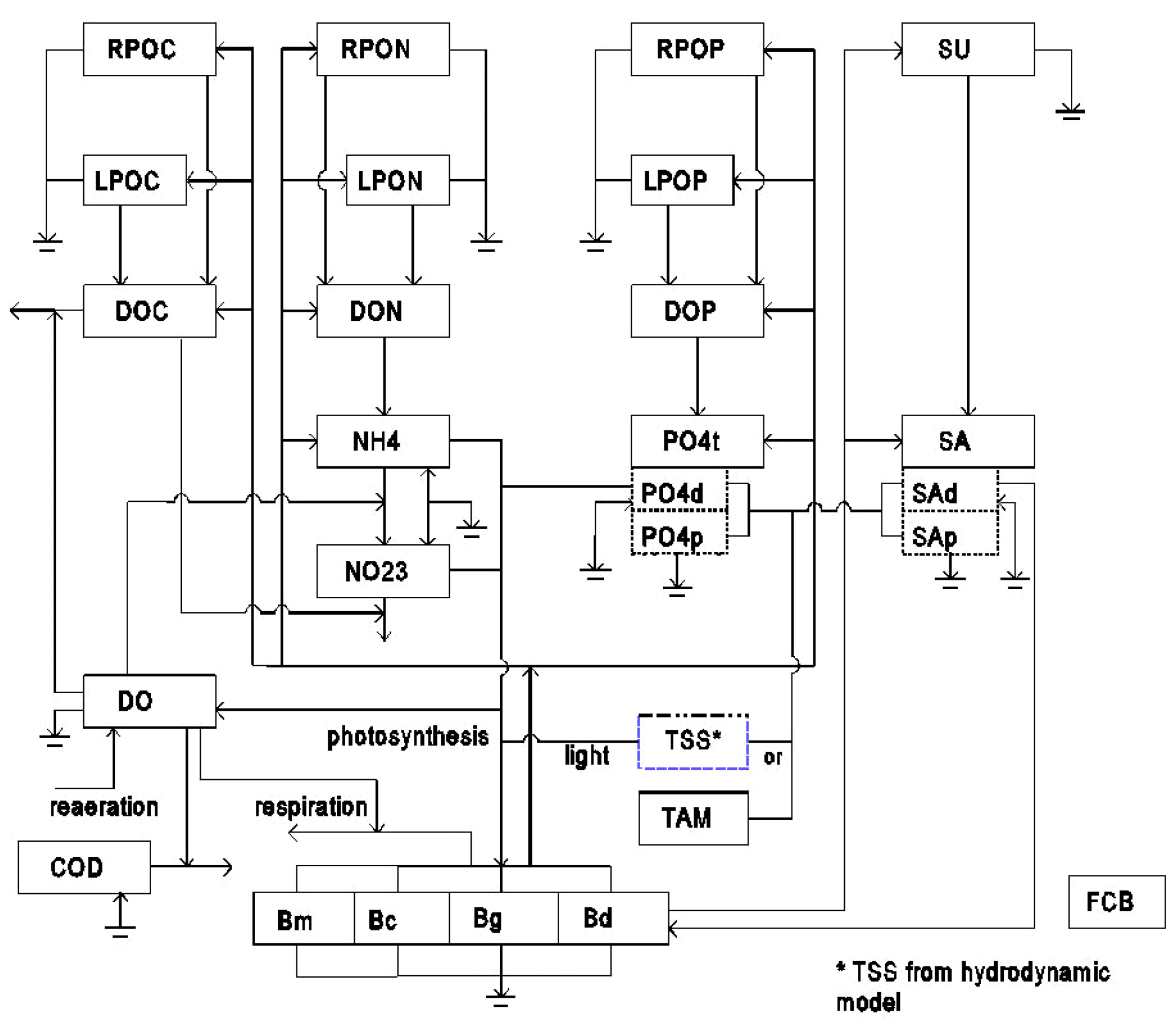
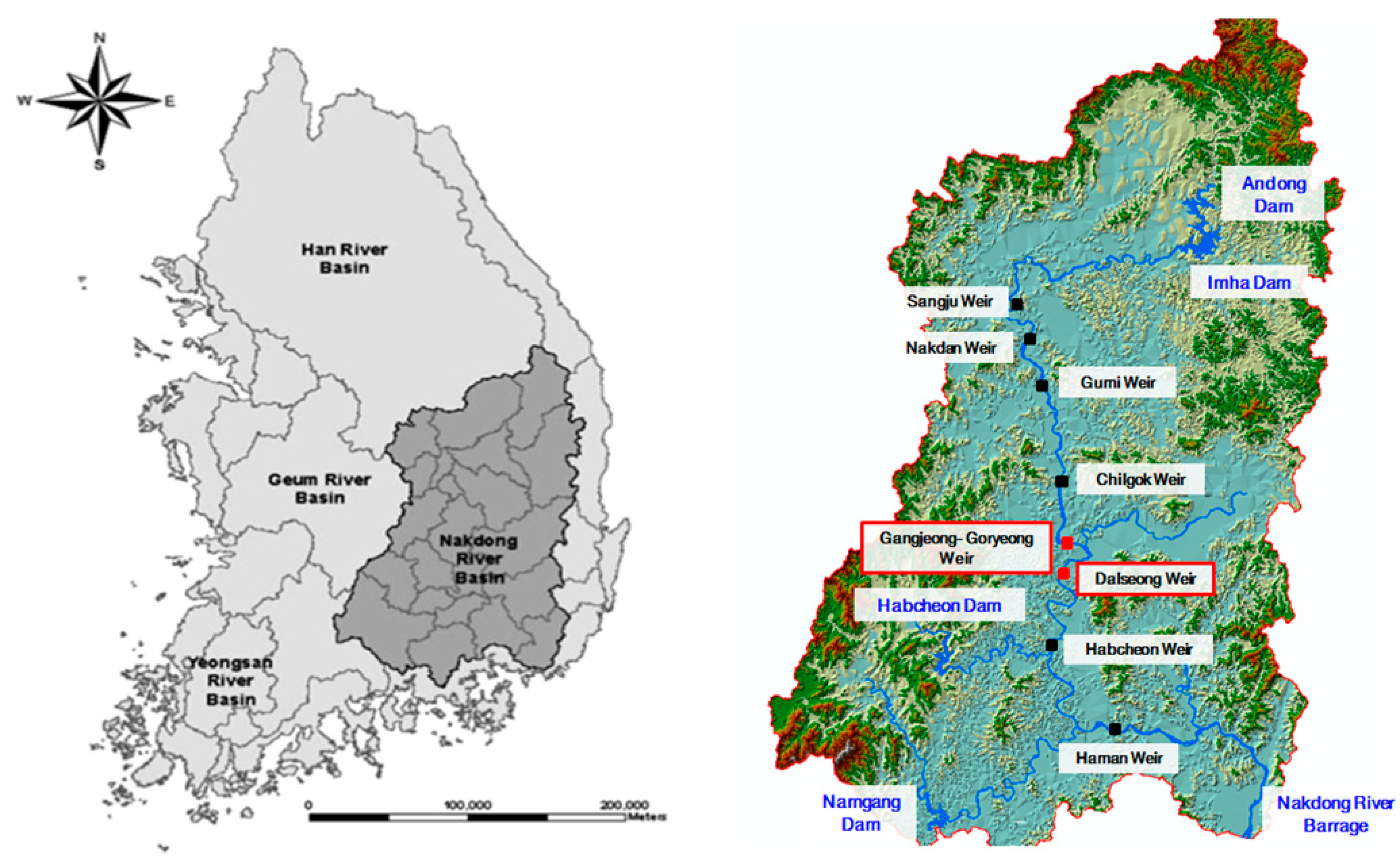
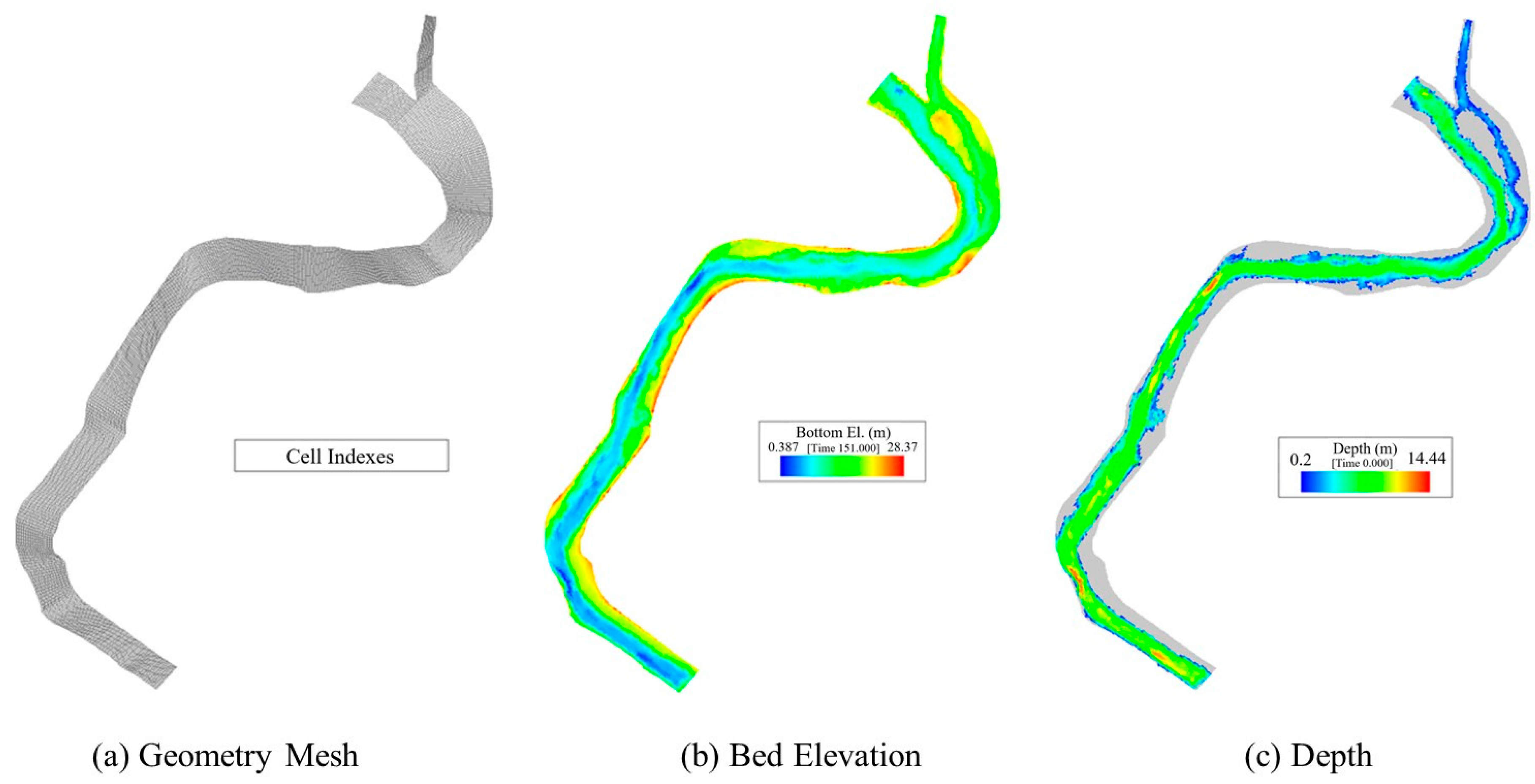
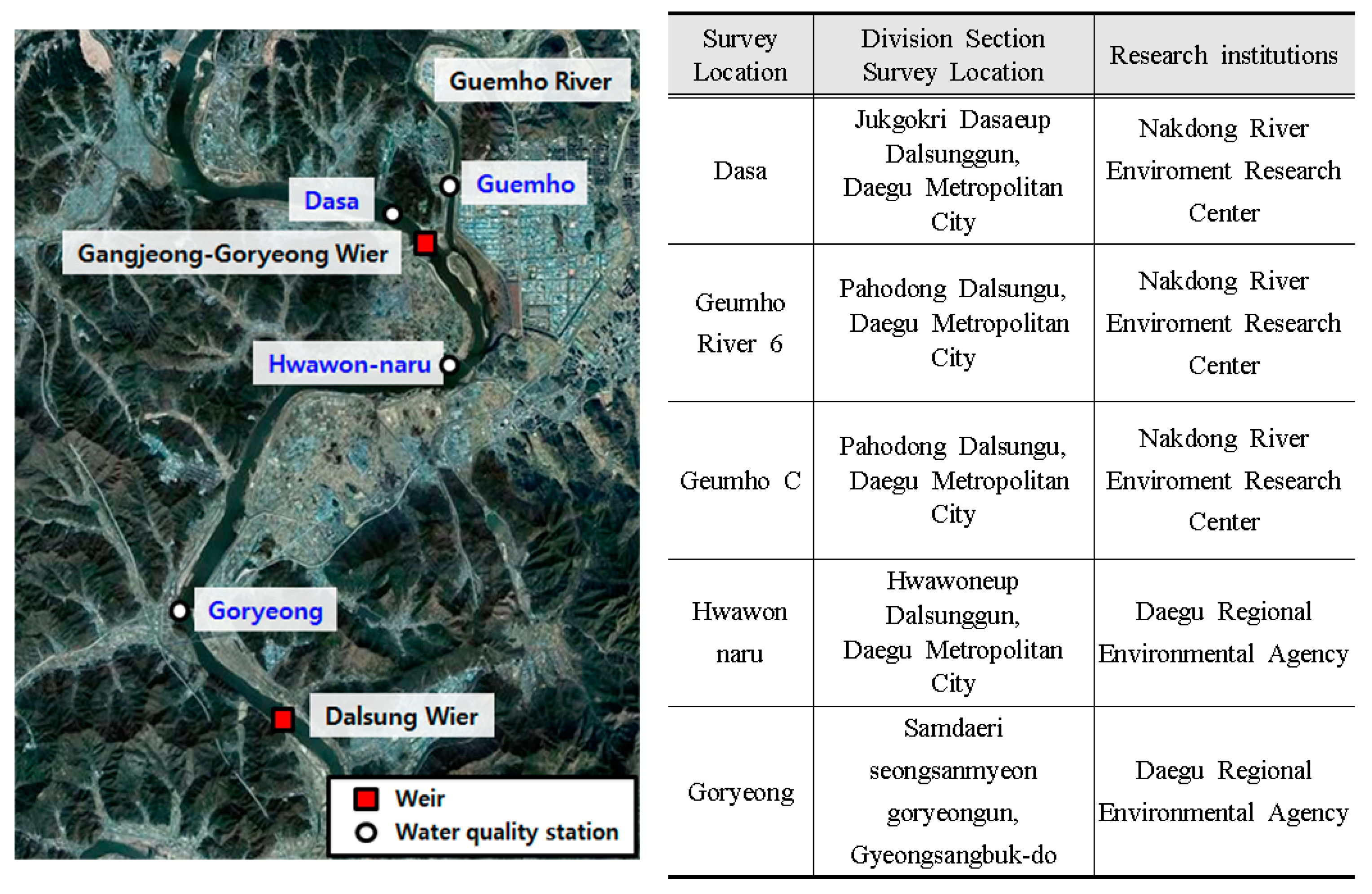
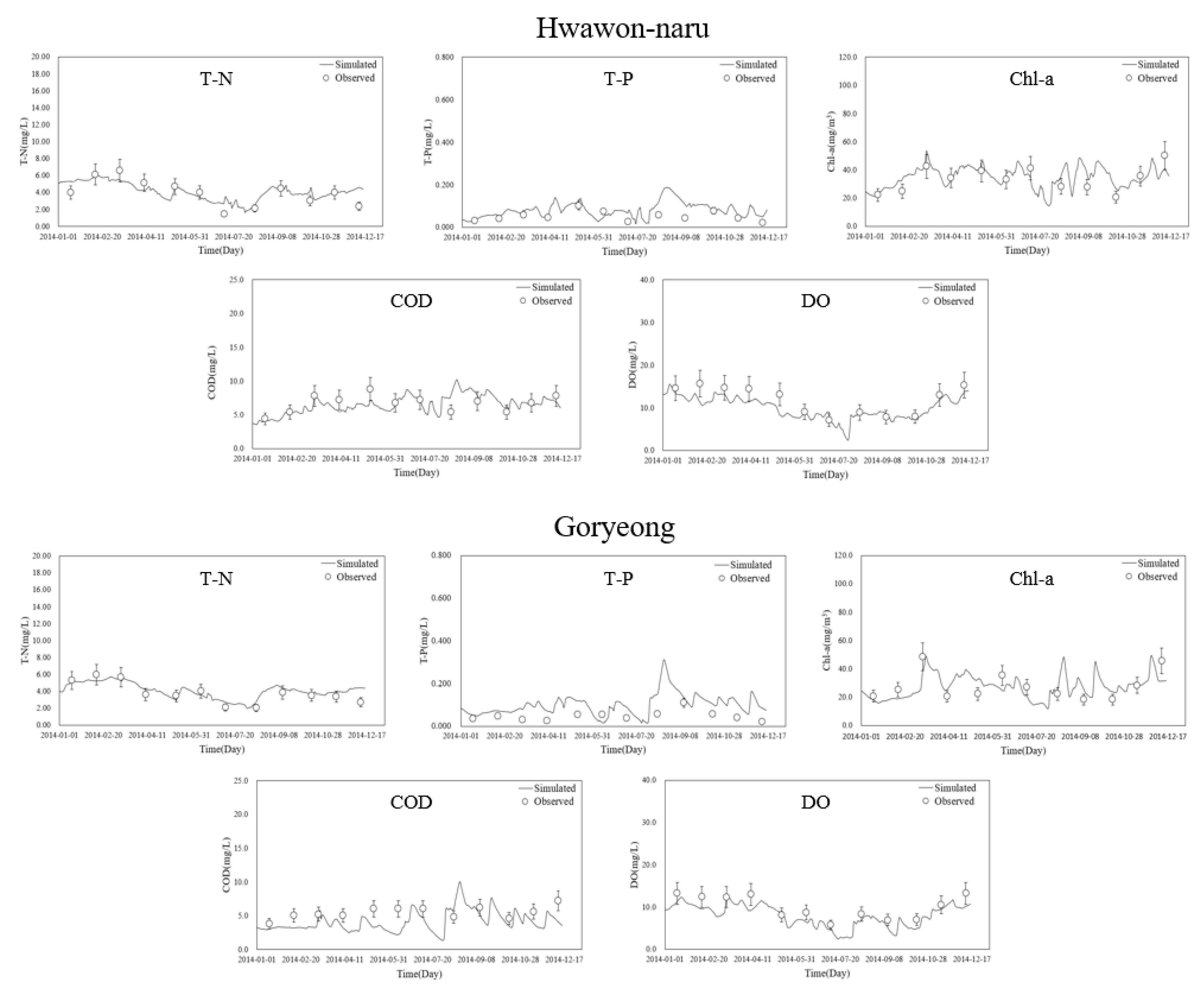
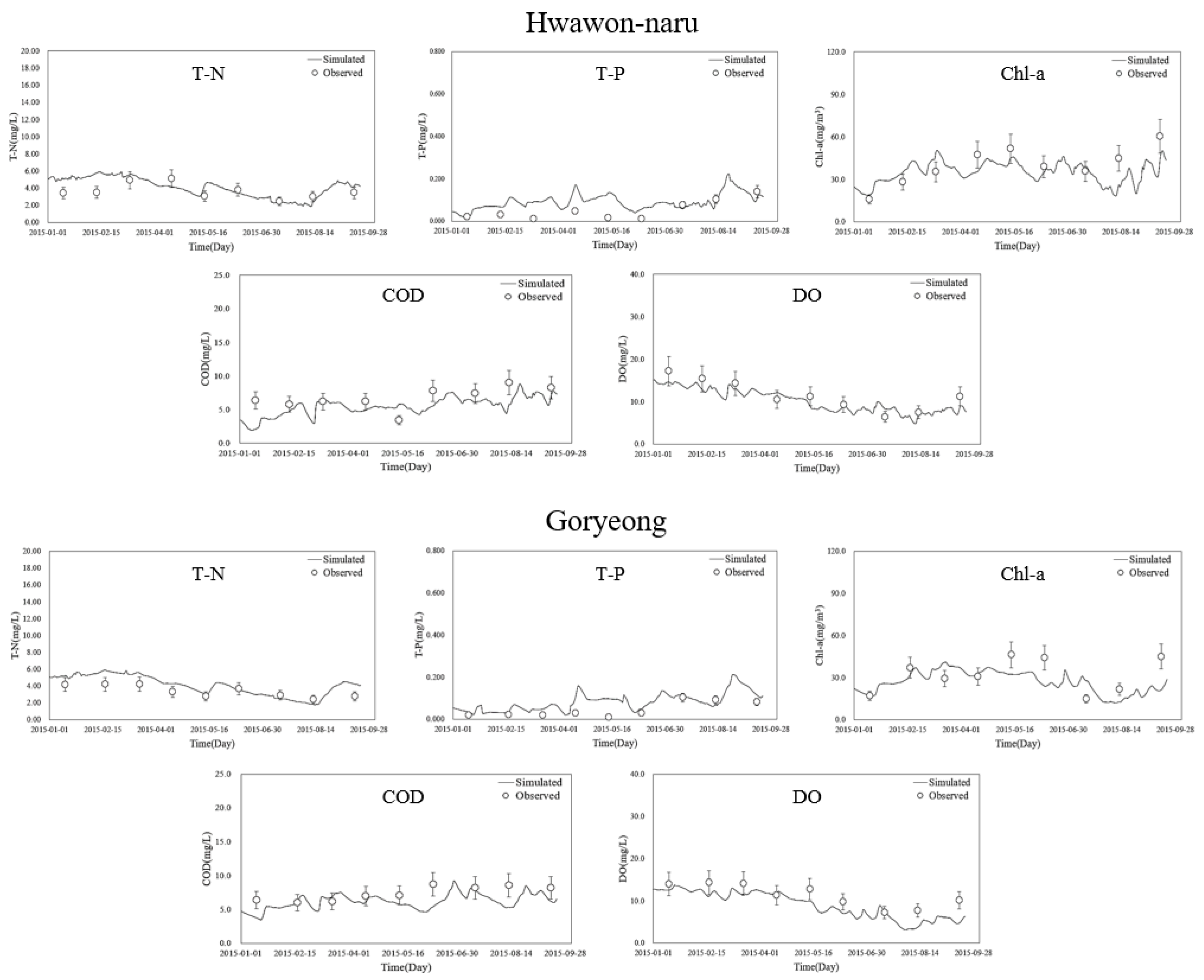
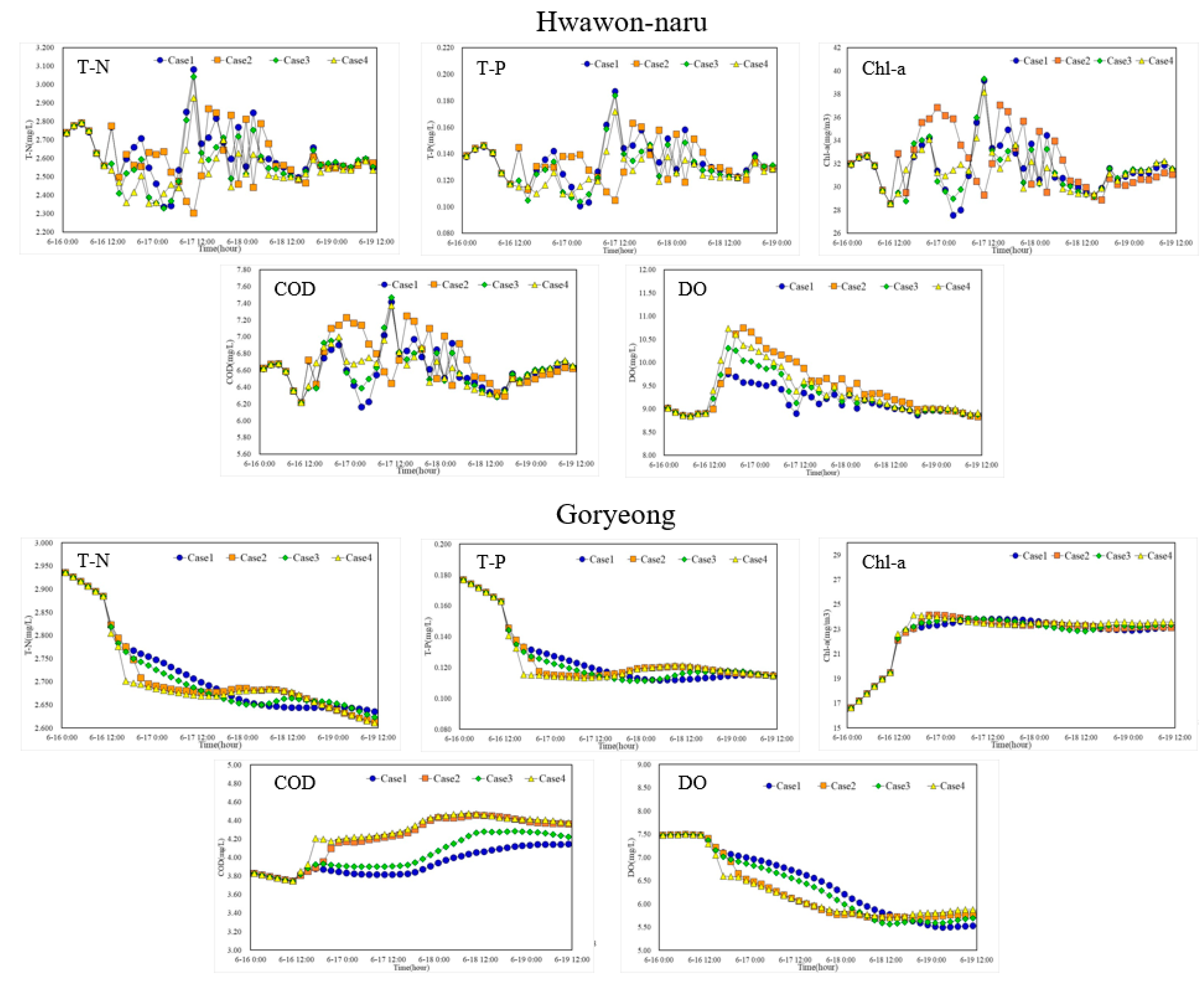

| Scenario | ||
|---|---|---|
| Case 1 | Real Case | 16 June 2015 Pulse Discharge actual operating Weir (11:00~16:00, Discharge: 274.2 m3/s~291.8 m3/s) |
| Case 2 | Real Case Discharge time extension | 16 June 2015 Pulse Discharge actual operating Weir + Discharge times, twice extended |
| Case 3 | Upstream Weir Operations | 16 June 2015 Pulse Discharge + GangjeongGoryeong Weir, Dalseong Weir 0.5 m opening gate |
| Case 4 | Upstream Weir Operations | 16 June 2015 Pulse Discharge + GangjeongGoryeong Weir, Dalseong Weir 1.0 m opening gate |
| Case 1 Contrast Case 2 Reduction Ratio | |||||||||||||||
|---|---|---|---|---|---|---|---|---|---|---|---|---|---|---|---|
| Time(hour) | Case | Chl-a | Chl-a | Case | DO (mg/L) | DO (%) | Case | COD (mg/L) | COD | Case | T-N (mg/L) | T-N (%) | Case | T-P (mg/L) | T-P (%) |
| (mg/m3) | (%) | (%) | |||||||||||||
| After 24 h | 1 | 31.2 | 7.68∇ | 1 | 9.4 | 6.49∇ | 1 | 6.57 | 4.48∇ | 1 | 2.57 | 0.22∇ | 1 | 0.126 | 3.99∇ |
| 2 | 33.4 | 2 | 10 | 2 | 6.85 | 2 | 2.57 | 2 | 0.128 | ||||||
| After 48 h | 1 | 33 | 0.41∇ | 1 | 9.2 | 4.46∇ | 1 | 6.76 | 0.79∇ | 1 | 2.71 | 1.86Δ | 1 | 0.145 | 2.73Δ |
| 2 | 32.9 | 2 | 9.6 | 2 | 6.8 | 2 | 2.64 | 2 | 0.139 | ||||||
| After 72 h | 1 | 30.7 | 1.52Δ | 1 | 8.9 | 0.88∇ | 1 | 6.5 | 0.30Δ | 1 | 2.56 | 0.48Δ | 1 | 0.13 | 0.99Δ |
| 2 | 30.2 | 2 | 9 | 2 | 6.48 | 2 | 2.54 | 2 | 0.128 | ||||||
| Case 1 Contrast Case 3 Reduction Ratio | |||||||||||||||
| Time(hour) | Case | Chl-a | Chl-a | Case | DO (mg/L) | DO (%) | Case | COD (mg/L) | COD | Case | T-N (mg/L) | T-N (%) | Case | T-P (mg/L) | T-P (%) |
| (mg/m3) | (%) | (%) | |||||||||||||
| After 24 h | 1 | 31.2 | 0.23∇ | 1 | 9.4 | 3.65∇ | 1 | 6.57 | 0.89∇ | 1 | 2.57 | 3.01Δ | 1 | 0.126 | 4.28Δ |
| 3 | 31.2 | 3 | 9.8 | 3 | 6.62 | 3 | 2.49 | 3 | 0.12 | ||||||
| After 48 h | 1 | 33 | 1.53Δ | 1 | 9.2 | 1.21∇ | 1 | 6.76 | 0.56Δ | 1 | 2.71 | 2.08Δ | 1 | 0.145 | 3.67Δ |
| 3 | 32.5 | 3 | 9.3 | 3 | 6.72 | 3 | 2.65 | 3 | 0.14 | ||||||
| After 72 h | 1 | 30.7 | 0.32∇ | 1 | 8.9 | 0.16∇ | 1 | 6.5 | 0.14∇ | 1 | 2.56 | 0.06Δ | 1 | 0.13 | 0.16Δ |
| 3 | 30.8 | 3 | 9 | 3 | 6.51 | 3 | 2.56 | 3 | 0.129 | ||||||
| Case 1 Contrast Case 4 Reduction Ratio | |||||||||||||||
| Time(hour) | Case | Chl-a | Chl-a | Case | DO (mg/L) | DO (%) | Case | COD (mg/L) | COD | Case | T-N (mg/L) | T-N (%) | Case | T-P (mg/L) | T-P (%) |
| (mg/m3) | (%) | (%) | |||||||||||||
| After 24 h | 1 | 31.2 | 2.06∇ | 1 | 9.4 | 6.32∇ | 1 | 6.57 | 2.33∇ | 1 | 2.57 | 4.17Δ | 1 | 0.126 | 4.97Δ |
| 4 | 31.7 | 4 | 10 | 4 | 6.71 | 4 | 2.5 | 4 | 0.118 | ||||||
| After 48 h | 1 | 33 | 3.10Δ | 1 | 9.2 | 2.13∇ | 1 | 6.76 | 1.23Δ | 1 | 2.71 | 4.08Δ | 1 | 0.145 | 7.21Δ |
| 4 | 31.9 | 4 | 9.4 | 4 | 6.67 | 4 | 2.59 | 4 | 0.134 | ||||||
| After 72 h | 1 | 30.7 | 0.17∇ | 1 | 8.9 | 0.57∇ | 1 | 6.5 | 0.05∇ | 1 | 2.56 | 0.85Δ | 1 | 0.13 | 1.68Δ |
| 4 | 30.8 | 4 | 9 | 4 | 6.5 | 4 | 2.54 | 4 | 0.127 | ||||||
Publisher’s Note: MDPI stays neutral with regard to jurisdictional claims in published maps and institutional affiliations. |
© 2022 by the authors. Licensee MDPI, Basel, Switzerland. This article is an open access article distributed under the terms and conditions of the Creative Commons Attribution (CC BY) license (https://creativecommons.org/licenses/by/4.0/).
Share and Cite
Han, J.-K.; Jung, W.-S.; Kim, J.-M.; Park, I.-H.; Kim, Y.-D. Analysis of Water Quality Improvement Effect of Controlled River by Multi-Functional Weir Operation. Appl. Sci. 2022, 12, 8883. https://doi.org/10.3390/app12178883
Han J-K, Jung W-S, Kim J-M, Park I-H, Kim Y-D. Analysis of Water Quality Improvement Effect of Controlled River by Multi-Functional Weir Operation. Applied Sciences. 2022; 12(17):8883. https://doi.org/10.3390/app12178883
Chicago/Turabian StyleHan, Jin-Kyoung, Woo-Suk Jung, Jung-Min Kim, In-Hwan Park, and Young-Do Kim. 2022. "Analysis of Water Quality Improvement Effect of Controlled River by Multi-Functional Weir Operation" Applied Sciences 12, no. 17: 8883. https://doi.org/10.3390/app12178883
APA StyleHan, J.-K., Jung, W.-S., Kim, J.-M., Park, I.-H., & Kim, Y.-D. (2022). Analysis of Water Quality Improvement Effect of Controlled River by Multi-Functional Weir Operation. Applied Sciences, 12(17), 8883. https://doi.org/10.3390/app12178883









